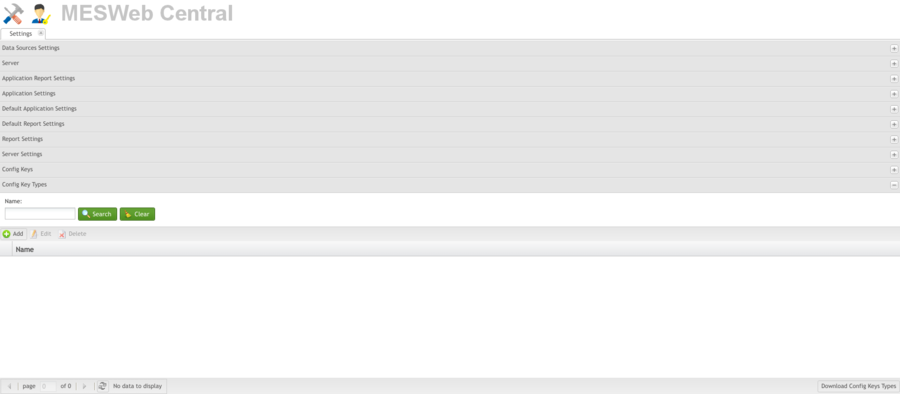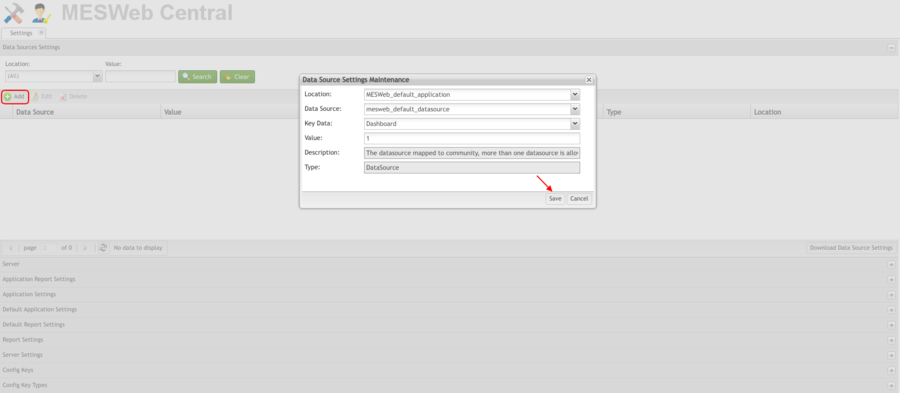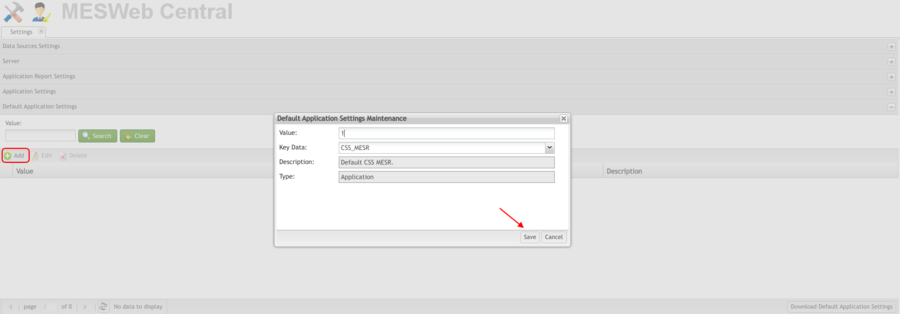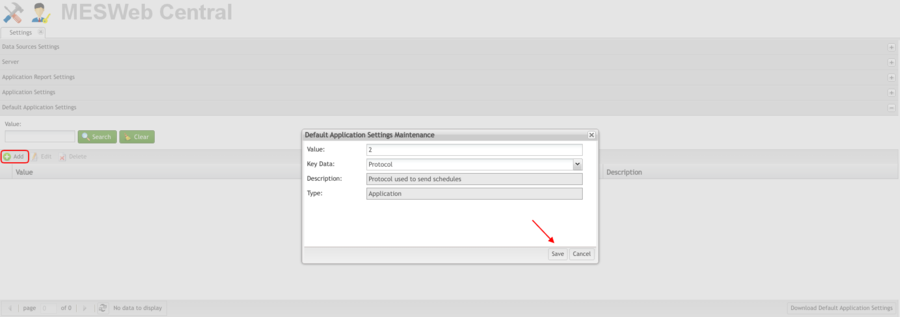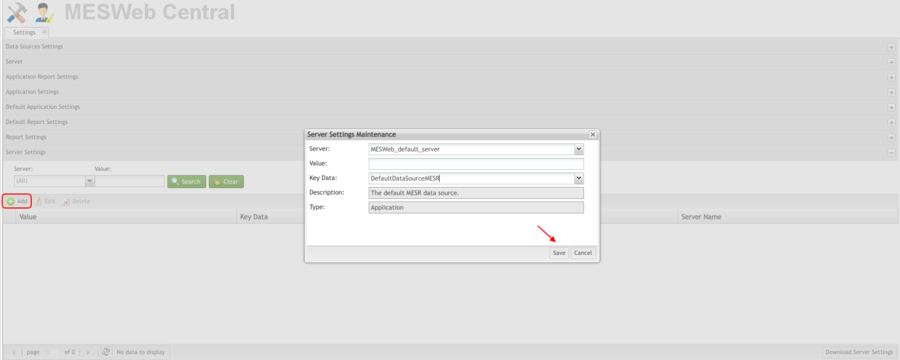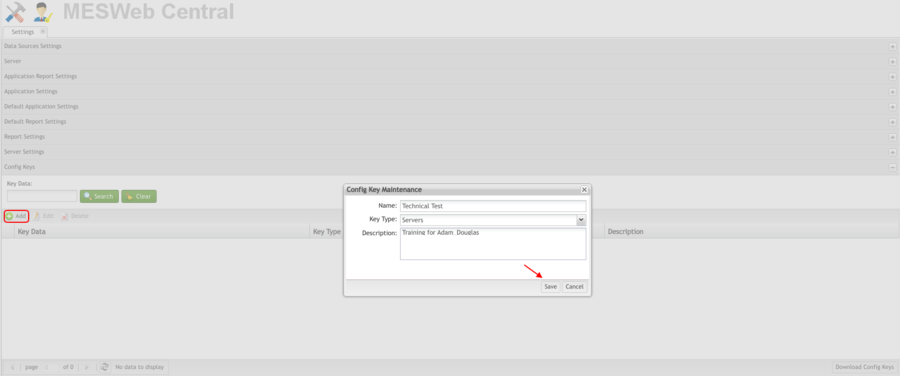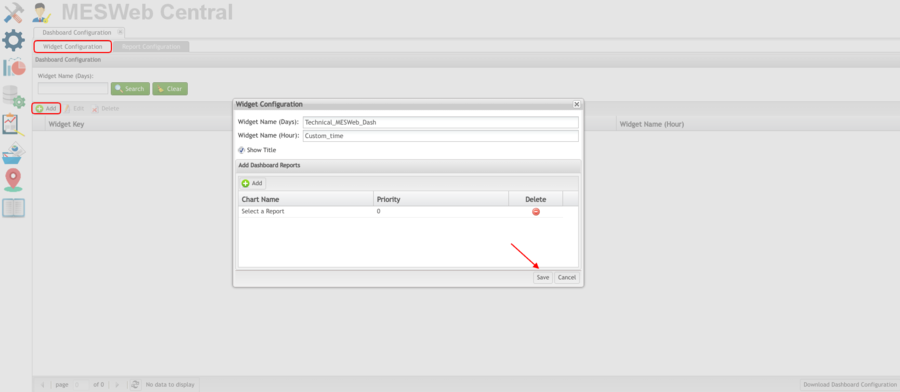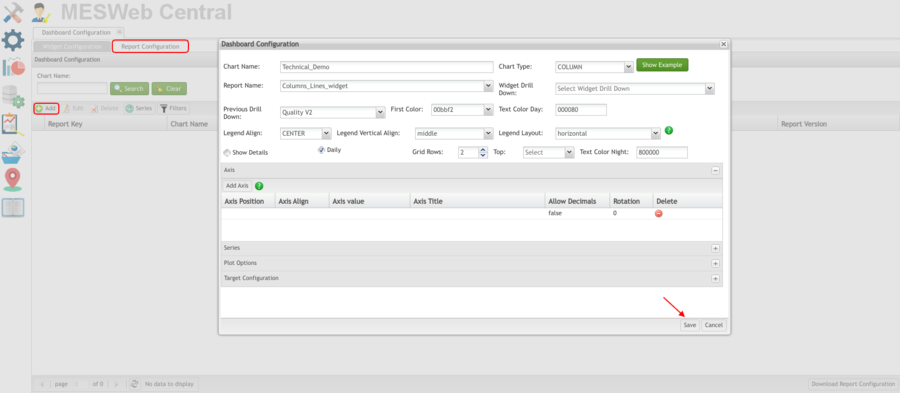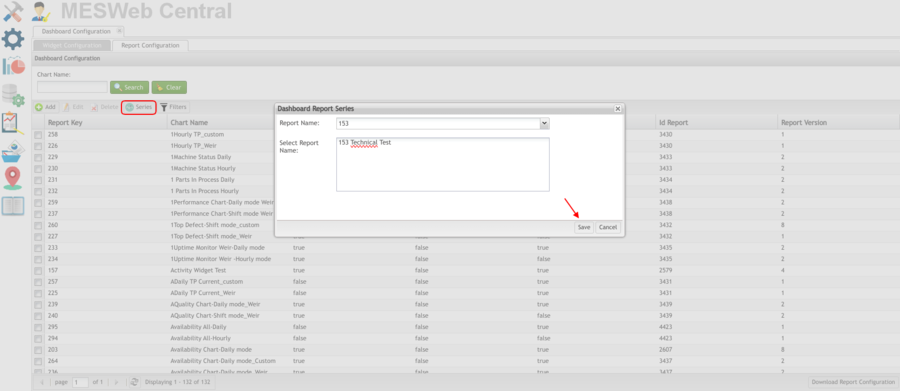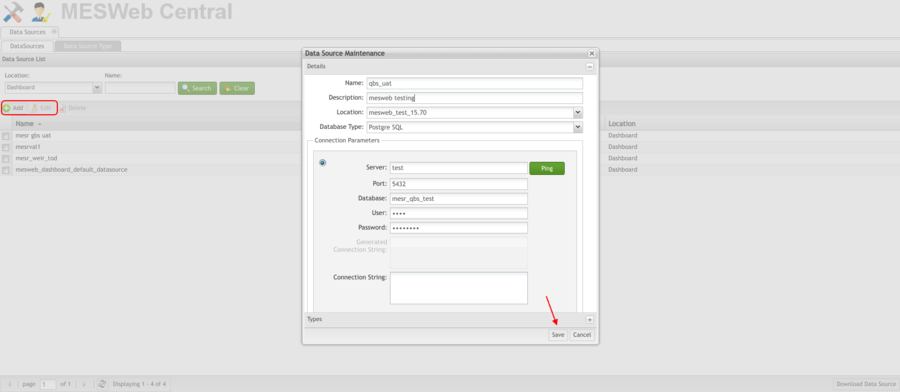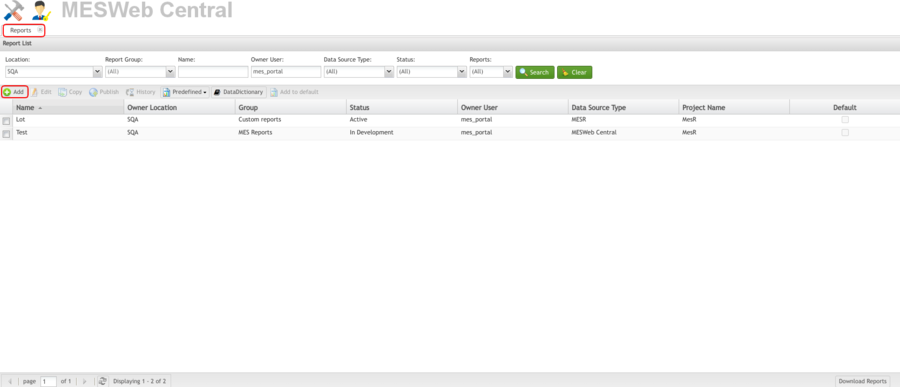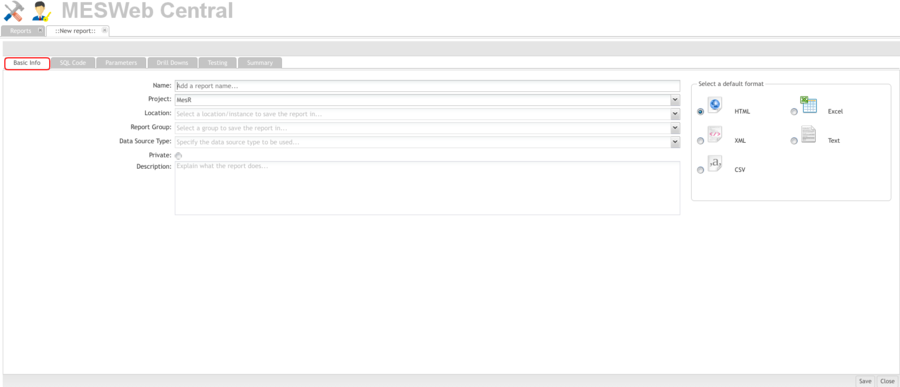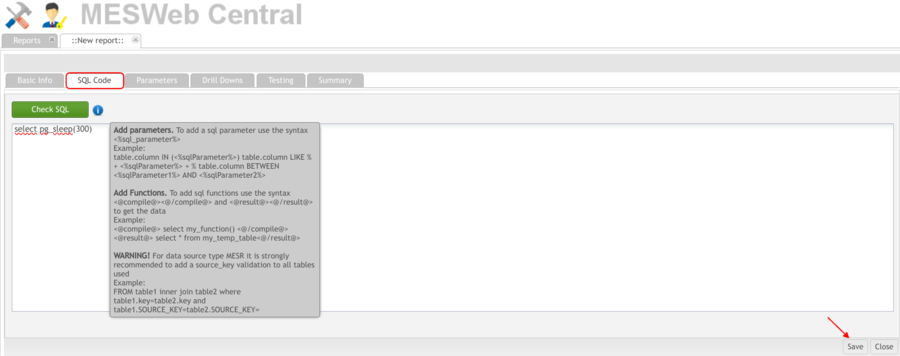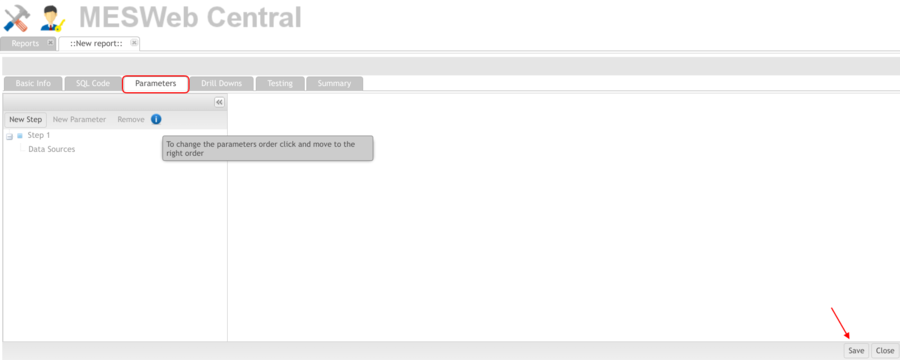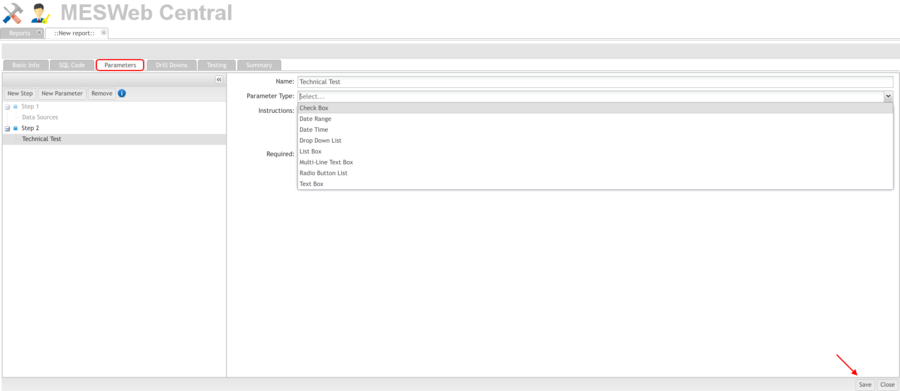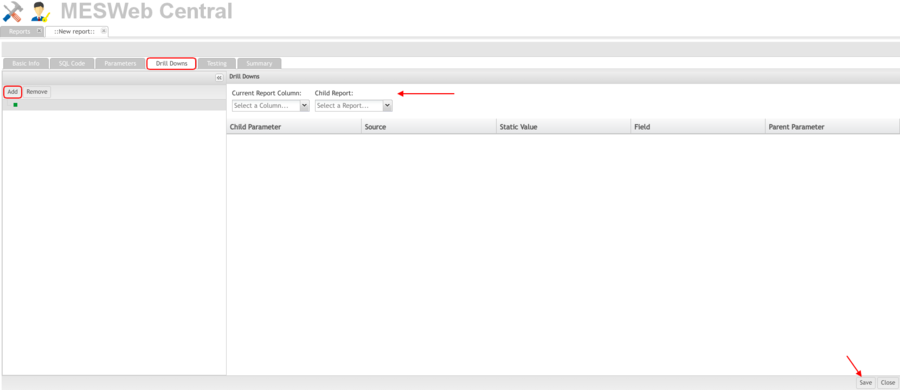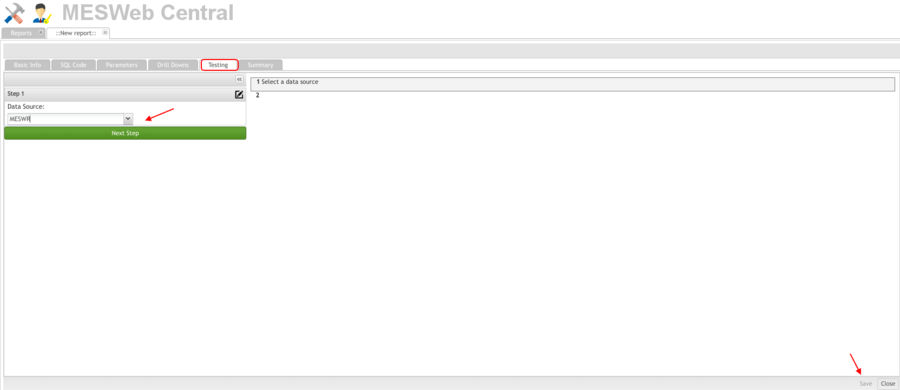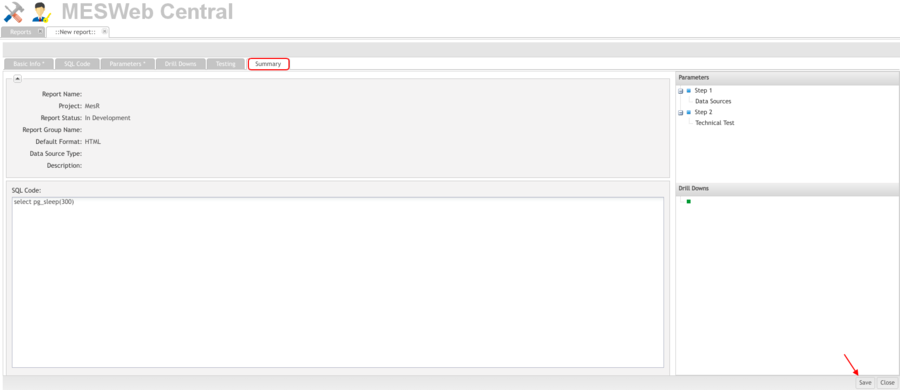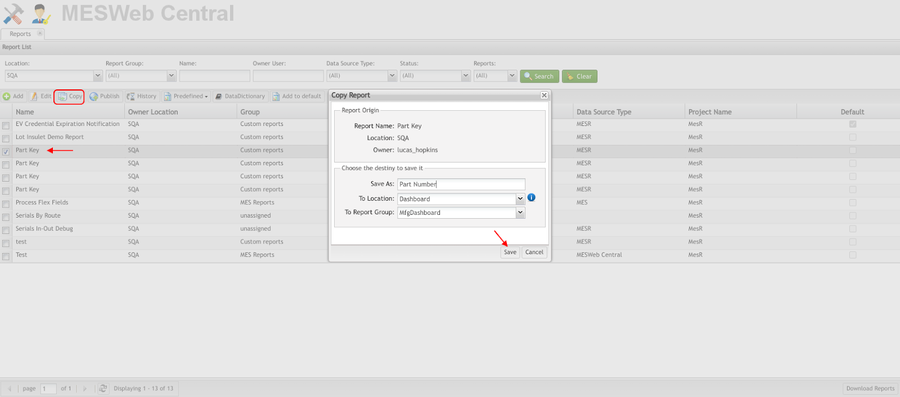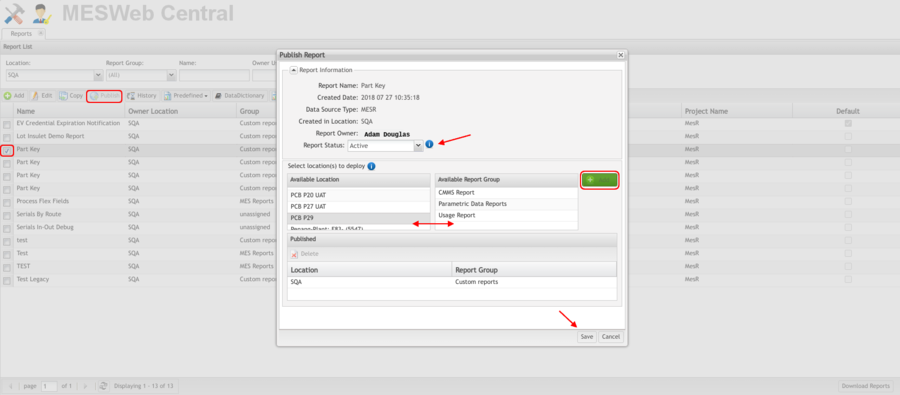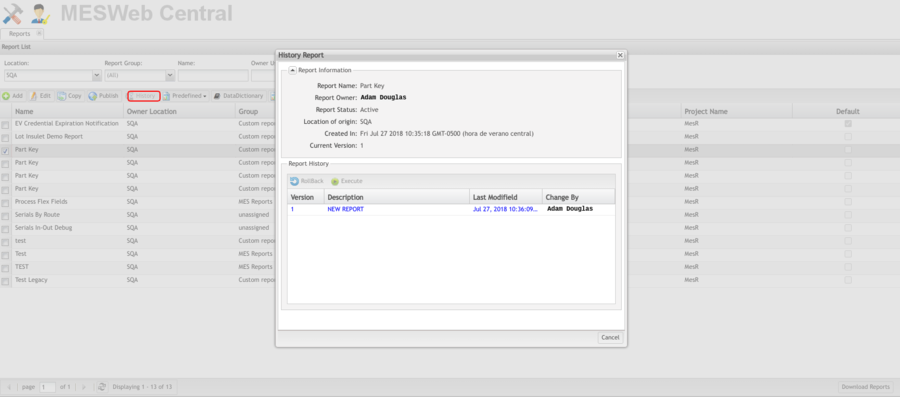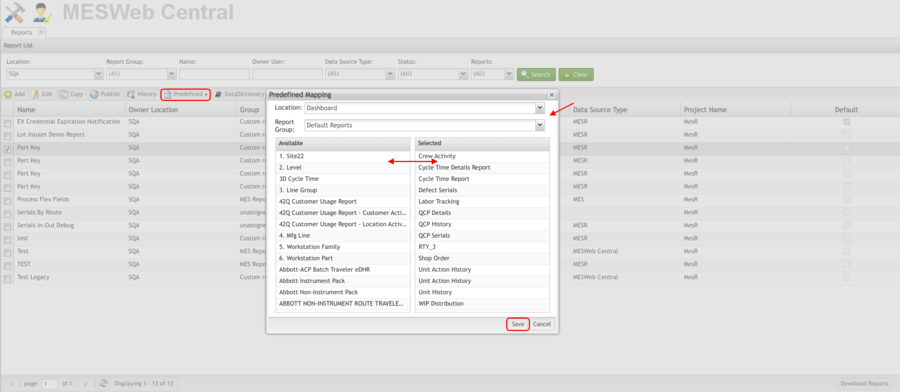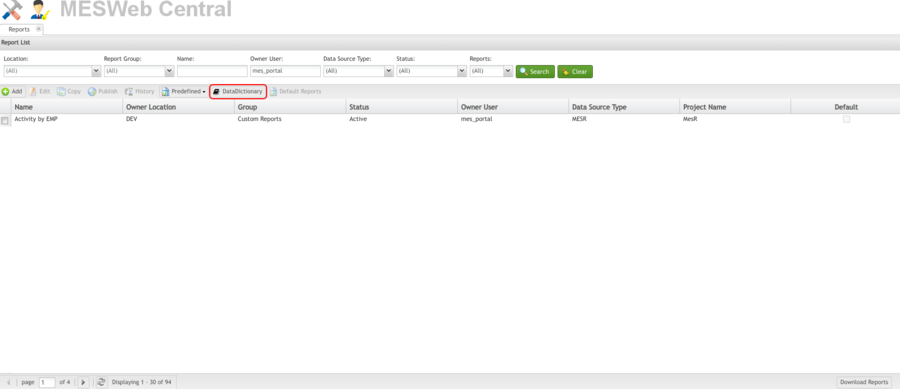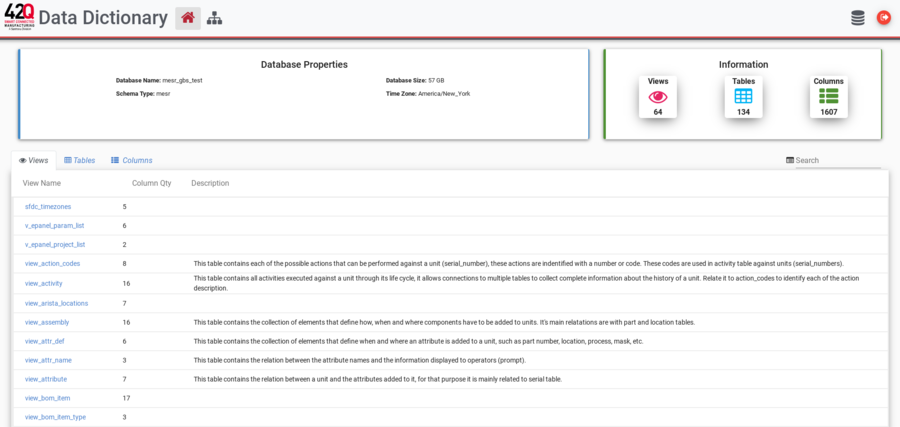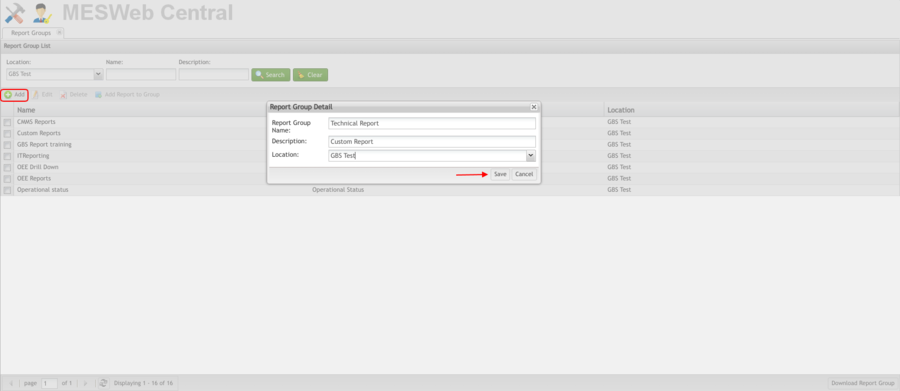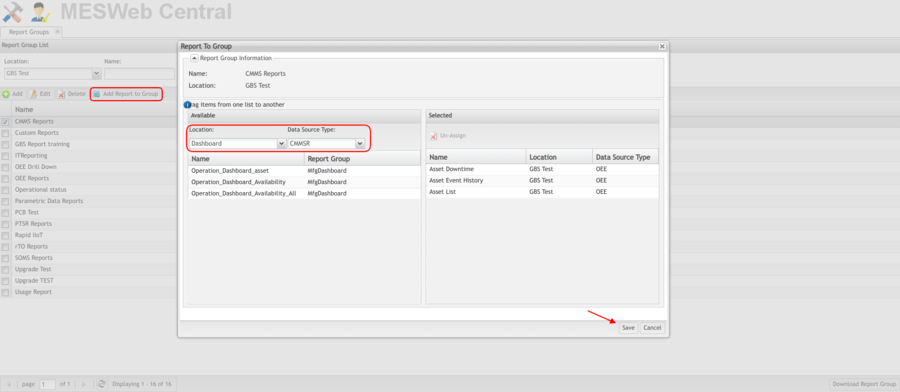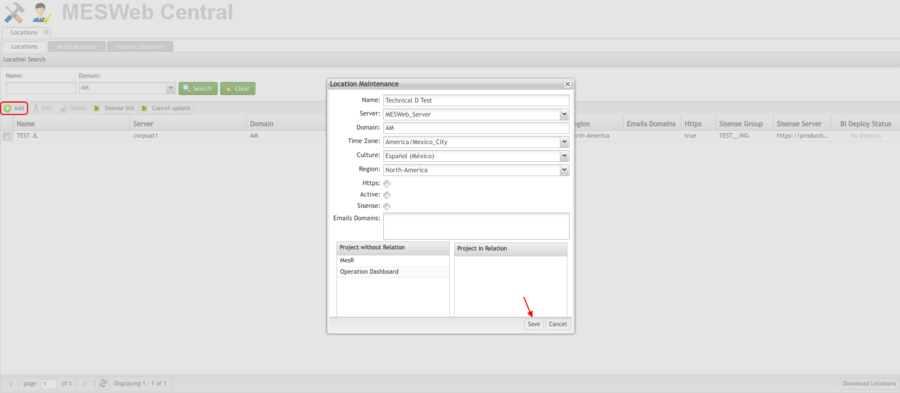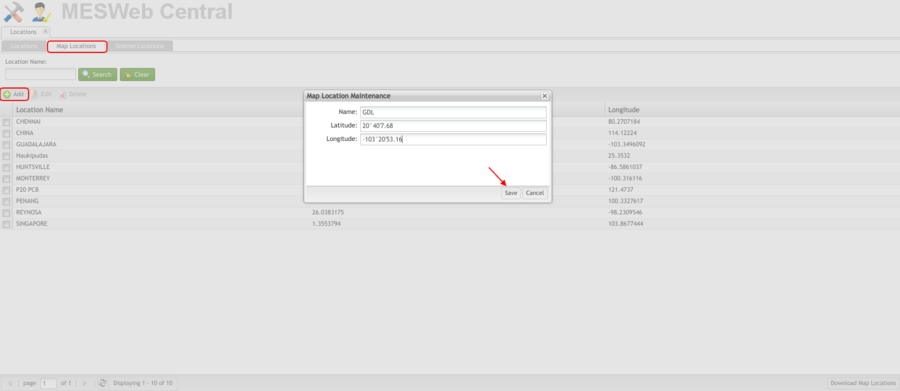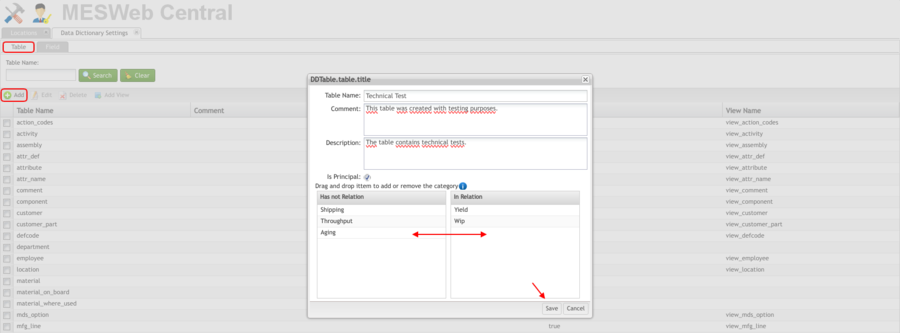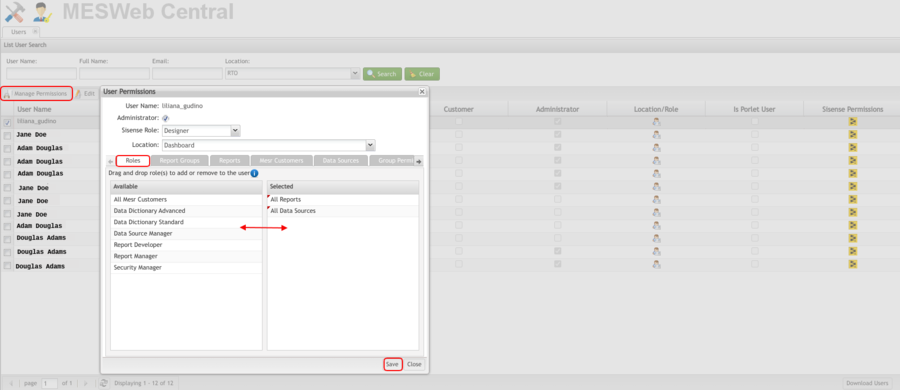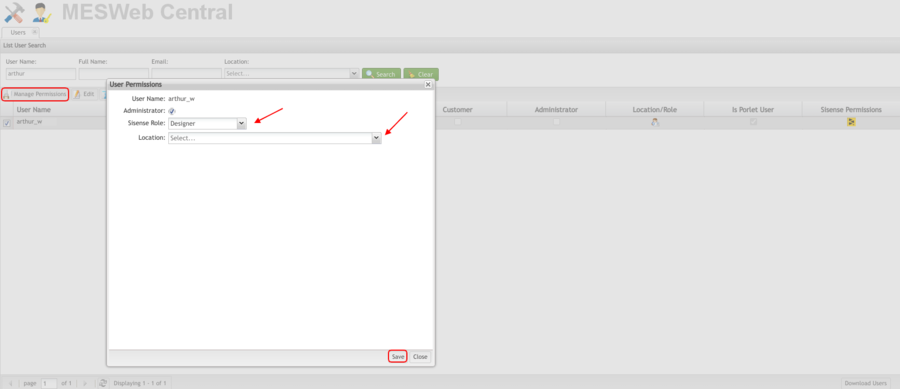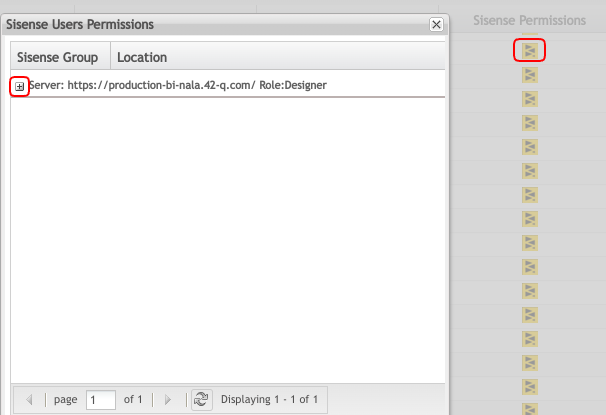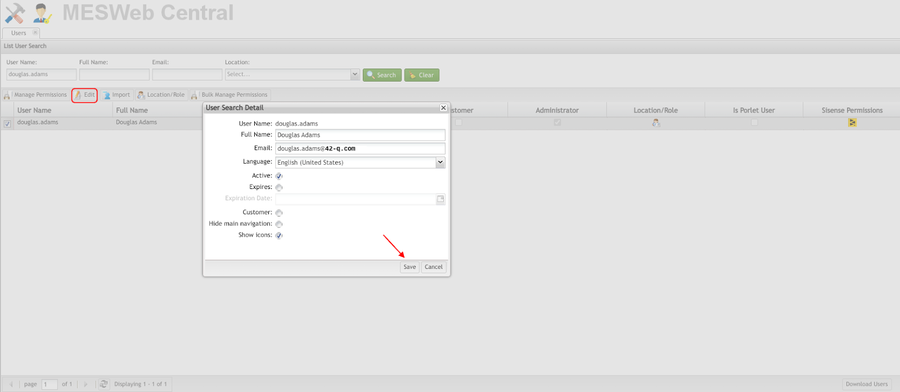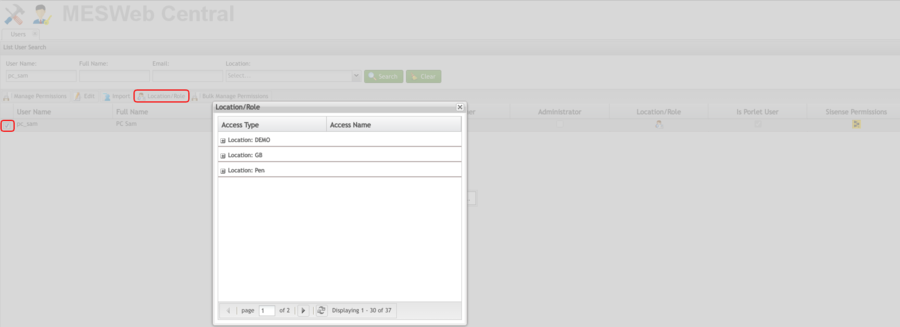SOP-MES0039 MESWeb Central
42Q Home > Administration > MESWeb Central
Contents
- 1 Introduction
- 2 Administration
- 2.1 Settings
- 2.2 Dashboard Configuration
- 2.3 Data Sources
- 2.4 Reports
- 2.5 Report Groups
- 2.6 Locations
- 2.7 Data Dictionary Settings
- 3 Access Control
- 4 Report Builder
Introduction
MESWeb is a powerful business intelligence application designed from the ground up to simplify reporting from manufacturing execution systems, and empower end-users with a streamlined and full-featured web interface. The application includes an ad hoc report design tool that allows users to easily build their own reports and modify existing ones with little to no training. Also, create rich, customized reports from heterogeneous data sources.
Decentralized custom reports, redundant data, lack of pop-up security controls, and convoluted development requirements are problems faced by all 42Q s, and MESWeb has been designed to resolve these issues while maximizing usability and performance.
The purpose of this application is to manage the permissions for every report in our MES Web application. It provides 42Q s with an easy mechanism for managing users, roles, applications, services, and the relations among them.
Administration
There are 2 types of roles in MESWeb, the first type grants certain permissions to the user in the Central module and those are:*
- Administrator: user with this role has full permissions to all locations in the Central module.
- Security Manager: can grant access to all kinds of permissions except Administrator to other users and himself, including roles and reports.
- Report Manager: this role has all permission in the Report Module but just for the specific Location assigned. (Create, edit, copy, and publish reports)
- Data Source Manager: this role has all permission in the Data source module but just for the specific Location assigned. (Create, edit, delete data sources)
The following roles will only take effect on the report execution:*
- All MESR Customers: this role allows the user to see all customers of a specific location.
- All data sources: this role allows users to see all data sources of a specific location.
- All Reports: this role allows the user to see and execute all reports available in a specific location.
To access MESWeb, navigate to Administration > MESWeb Central
The main screen will show two icons in the top left corner, Administrator and Access Control.
Once selecting the Administration icon, seven additional icons become available:
- Settings
- Dashboard Configuration
- Data Sources
- Reports
- Report Groups
- Location
- Data Dictionary Settings
Settings 
The Settings section is organized as an accordion layout that allows easy access to each functionality, in this way, when the user clicks each section will be able to see the screen related to that section. In this section, users can configure applications, data sources, servers, and reports.
Figure 1: Functions in Tabs
Data Source Settings
In this section, the user can configure the data source for the Dashboard and 42Q Live application.
TheData Source function is located in the Settings menu and allows the administrators' users to add, edit or delete the Data Sources.
To access the Data Source function, click on the Data Source menu located under the Settings menu or select “+” icon.
The Data Source List displays containing all previously created data sources, listed numerically and alphabetically. From this screen, the Administrator can add, edit or delete data sources.
To perform a search at the Data Source List, fill at least one field and click on Search to continue.
Figure 2: Data Source Main Page
Add Data Source Settings
This function allows the Administrator to add a data source setting based on the Location, Data Source, Value, Key Data, Description, and Type.
Follow the steps below to add Data Source Settings:
1. To add a Data Source Setting, select Add located above the Data Source Settings list.
2. The Data Source Settings Maintenance pop-up displays. Fill in the fields and select Save.
3. Select Cancel to exit. A successful message is displayed. Once the data source settings have been entered and saved, the created data source will appear in the list.
Figure 3: Data Source Add
Edit Data Source Settings
1. To edit a Data Source Settings, select the desired data source setting from the list.
2. Select Edit located above the Data Source list.
3. The Data Source Settings Maintenance pop-up displays. After editing the data, select Save to confirm.
4. Select Cancel to exit.
Figure 4: Data Source Edit
Delete Data Source Settings
- To delete a Data Source Settings, select the Data Source from the list.
- Select Delete located above the Data Source list.
- A confirmation message is displayed. Selected to confirm or No to exit.
Server
Server is where the MESWeb Execution application is installed.
The Server function is located in the Settings menu and allows the administrator users to add, edit or delete the servers.
To access the Server function, click on the server menu located under the Settings menu or select “+”' icon.
A Server list displays containing all previously created servers listed numerically and alphabetically. From this screen, the Administrator can add, edit or delete a server.
To perform a search at the Server List:
- Fill at least one field
- Select on Serach to continue
- The list will be displayed according to the uiser search
Add Server Name
1. To add a server, select Add located above the server name list.
2. The Server Detail pop-up displays. Enter a name for the server and select Save.
3. Select Cancel to exit.
4. Once the server name has been entered and saved, the created server will appear in the server list.
Figure 5: Add a Server Name
Edit Server Name
1. To edit a Server name, select the desired server name from the list.
2. Select Edit located above the server name list.
3. The Server Detail pop-up displays. After editing the server name, select Save to confirm.
4. Select Cancel to exit.
Delete Server
1. To delete a server, select the server name from the server list.
2. Select Delete located above the server name list.
3. A confirmation message is displayed. Select Yes to confirm or No to exit.
Note: If the server has any location assigned, it will not be allowed to delete the server.
Application Report Settings
In this section, the user can customize the configurations of the reports that belong to a specific application.
The Application Report function is located in the Settings menu and allows the administrators' users to add, edit or delete the Application Reports.
To access the Application Report function, click on the Application Report Settings menu located under the Settings menu or select “+” icon.
To perform a search at the Application Report Settings List
- fill at least one field and click on Search to continue.
- Select on the Serch button to continue.
- The List will be displayed according to the user search.
Add Application Report Settings
1. To add an Application Report Settings, select Add located above the Application Report Settings list.
2. The Application Report Settings Maintenance pop-up displays. Fill the fields and select Save.
3. Select Cancel to exit. A successful message is displayed.
4. Once the Application Report Settings have been entered and saved, the created data source will appear in the list.
Figure 6: Add Application Report Settings
Edit Application Report Settings
1. To edit an Application Report Settings, select the desired App. Report Setting from the list.
2. Select Edit located above the Application Report Settings list.
3. The Application Report Settings Maintenance pop-up displays. After editing the desired fields, select Save to confirm.
4. Select Cancel to exit.
Delete Application Report Settings
1. To delete the Application Report Settings, select the Application Report from the list.
2. Select Delete located above the Application Report Settings list.
3. A confirmation message is displayed. Select Yes to confirm or No to exit.
Application Settings
In this section, the user can configure the application.
The Application Settings function is located in the Settings menu and allows the administrators' users to add, edit or delete the Application Settings.
To access the Application Settings function, click on the Application Settings menu located under the Settings menu or select “+” icon.
Filter Application Settings
To perform a search at the Application Settings List, fill at least one field and click on Search to continue. The List will be displayed according to the user search.
Application Settings
1. To add Application Settings, select Add located above the Application Settings list.
2. The Application Settings Maintenance pop-up displays. Fill in the fields and select Save.
3. Select Cancel to exit. A successful message is displayed.
4. Once the Application Settings have been entered and saved, the created Application Settings will appear in the list.
Figure 7: Add Application Settings
Edit Application Settings
1. To edit an Application Settings, select the desired App. Settings from the list.
2. Select Edit located above the Application Settings list.
3. The Application Settings Maintenance pop-up displays. After editing the desired fields, select Save to confirm.
4. Select Cancel to exit.
Delete Application Settings
1. To delete Application Settings, select the Application Settings from the list.
2. Select Delete located above the Application Settings list.
3. A confirmation message is displayed. Select Yes to confirm or No to exit.
Default Application Settings
In this section, the user can specify the default values to be used in a specific application. In this section, the user can add new CSS to override existing ones or add javascript codes.
The Default Application Settings function is located in the Settings menu and allows the administrators' users to add, edit or delete the Default Application Settings.
- To access the Default Application Settings function, click on the Default Application Settings menu located under the Settings menu or select “+” icon.
Filter Default Application Settings
- To perform a search at the Default Application Settings List, fill the Value field and click on Search to continue.
- The List will be displayed according to the user search.
Add Default Application Settings
1. To add a Default Application Settings, select Add located above the Default Application Settings list.
2. The Default Application Settings Maintenance pop-up displays. Fill the fields and select Save.
3. Select Cancel to exit. A successful message is displayed.
4. Once the Default Application Settings have been entered and saved, the created Default Application Settings will appear in the list.
Figure 8: Add Default Application Settings
Edit Default Application Settings
1. To edit Default Application Settings, select the desired Default Application Settings from the list.
2. Select Edit located above the Default Application Settings list.
3. The Default Application Settings Maintenance pop-up displays. After editing the desired fields, select Save to confirm.
4. Select Cancel to exit.
Delete Default Application Settings
1. To delete Default Application Settings, select Default Application Settings from the list.
2. Select Delete located above the Default Application Settings list.
3. A confirmation message is displayed. Select Yes to confirm or No to exit.
Default Report Setting
In this section, the user can specify the default values to be used in a specific report. In this section, the user can add new CSS to override existing ones or add javascript codes.
The Default Report Settings function is located in the Settings menu and allows the administrators' users to add, edit or delete the Default Report Settings.
To access the Default Report Settings function, click on the Default Report Settings menu located under the Settings menu or select “+” icon.
Add Default Report Settings
1. To add a Default Report Settings, select Add located above the Default Report Settings list.
2. The Default Report Settings Maintenance pop-up displays. Fill in the fields and select Save.
3. Select Cancel to exit. A successful message is displayed.
Once the Default Report Settings have been entered and saved, the created Default Report Settings will appear in the list.
Figure 9: Application Report Settings Maintenance to Add Default Report Settings
Edit Default Report Settings
1. To edit a Default Report Settings, select the desired Default Report Settings from the list.
2. Select Edit located above the Default Report Settings list.
3. The Default Report Settings Maintenance pop-up displays. After editing the desired fields, select Save to confirm.
4. Select Cancel to exit.
Delete Default Report Settings
1. To delete Default Report Settings, select Default Report Settings from the list.
2. Select Delete located above the Default Report Settings list.
3. A confirmation message is displayed. Select Yes to confirm or No to exit.
Report Settings
In this section, the user can customize configurations just for one report. One of the values that the user can change in this section is the timeout of the report
The Report Settings function is located in the Settings menu and allows the administrators' users to add, edit or delete the Report Settings.
To access the Report Settings function, click on the Report Settings menu located under the Settings menu or select “+” icon.
Filter Report Settings
1. To perform a search at the Report Settings List, fill at least one field and click on Search to continue.
2. The List will be displayed according to the user search.
Add Report Settings
1. To add a Report Settings, select Add located above the Report Settings list.
2. The Report Settings Maintenance pop-up displays. Fill in the fields and select Save.
3. SelectCancel to exit. A successful message is displayed.
4. Once the Report Settings have been entered and saved, the created Report Settings will appear in the list.
Figure 10: Add Report in Application Report Settings Maintenance
Edit Report Settings
1. To edit a Report Settings, select the desired Report Settings from the list.
2. Select Edit located above the Report Settings list.
3. The Report Settings Maintenance pop-up displays. After editing the desired fields, select Save to confirm.
4. Select Cancel to exit.
Delete Report Settings
1. To delete Report Settings, select Report Settings from the list.
2. Select Delete located above the Report Settings list.
3. A confirmation message is displayed. Select Yes to confirm or No to exit.
Server Settings
In this section, the user can configure settings for a specific server. In Mesweb a server is a container of applications. All these settings will apply to the whole server.
The Server Settings function is located in the Settings menu and allows the administrators' users to add, edit or delete the Server Settings.
- To access the Server Settings function, click on the Server Settings menu located under the Settings menu or select “+” icon.
Filter Server Settings
To perform a search at the Server Settings List, fill at least one field and select on Search to continue. The List will be displayed according to the user search.
Add Server Settings
1. To add a Server Settings, select Add located above the Server Settings list.
2. The Server Settings Maintenance pop-up displays. Fill in the fields and select Save.
3. Select Cancel to exit. A successful message is displayed.
4. Once the Server Settings have been entered and saved, the created Server Settings will appear in the list.
Figure 11: Add Server Settings
Edit Server Settings
1. To edit Server Settings, select the desired Server Settings from the list.
2. Select Edit located above the Server Settings list.
3. The Server Settings Maintenance pop-up displays. After editing the desired fields, select Save to confirm.
4. Select Cancel to exit.
Delete Server Settings
1. To delete Server Settings, select Server Settings from the list.
2. Select Delete located above the Server Settings list.
3. A confirmation message is displayed. Select Yes to confirm or No to exit.
Config Keys
Configuration Key is the key assigned to a configuration. If the user/administrator wants to create a new configuration, first the user/administrator needs to create a config key. In this section, they can create a new configuration available for the rest of the screens.
The Configuration Keys function is located in the Settings menu and allows the administrators' users to add, edit or delete the Config Keys.
1. To access the Config Keys function, click on the Config Keys menu located under the Settings menu or select “+” icon.
Filter Config Keys
To perform a search at the Config Keys List, fill Key Data field and click on Search to continue. The List will be displayed according to the user search.
Add Config Keys
1. To add a Config Keys, select Add located above the Config Keys list.
2. The Config Keys Maintenance pop-up displays. Fill in the fields and select Save.
3. Select Cancel to exit. A successful message is displayed.
4. Once the Config Keys have been entered and saved, the created Config Keys will appear in the list.
Figure 12: Add Config Keys
Edit Config Keys
1. To edit Config Keys, select the desired Config Key from the list.
2. Select Edit located above the Config Keys list.
3. The Config Key Maintenance pop-up displays. After editing the desired fields, select Save to confirm.
4. Select Cancel to exit.
Delete Config Keys
1. To delete Config Keys, select a Config Key from the list.
2. Select Delete located above the Config Keys list.
3. A confirmation message is displayed. Select Yes to confirm or No to exit.
Config Key Types
Definition: Config Key Type is a category to group our custom configurations. The user/administrator can create a new Config Key Type if they want a new category for configurations.
The Config Key Types function is located in the Settings menu and allows the administrators' users to add, edit or delete the Config Key Types.
- To access the Config Key Types function, click on the Config Key Types menu located under the Settings menu or select “+” icon.
Filter Config Key Types
To perform a search at the Config Key Types List, fill the Name field and click on Search to continue. The List will be displayed according to the user search.
Add Config Keys Types
1. To add a Config Key Types, select Add located above the Config Key Types list.
2. The Config Key Types Maintenance pop-up displays. Fill in the fields and select Save.
3. Select Cancel to exit. A successful message is displayed.
4. Once the Config Key Type has been entered and saved, the created Config Key Type will appear in the list.
Figure 13: Add Config Key Type
Edit Config Key Type
1. To edit Config Key Types, select the desired Config Key Type from the list.
2. Select Edit located above the Config Key Types list.
3. The Config Key Type Maintenance pop-up displays. After editing the desired fields, select Save to confirm.
4. Select Cancel to exit.
Delete Config Key Type
1. To delete Config Key Types, select a Config Key Type from the list.
2. Select Delete located above the Config Key Types list.
3. A confirmation message is displayed. Select Yes to confirm or No to exit.
Dashboard Configuration 
The Dashboard Configuration section allows the user to configure widgets and reports as displayed in the next steps.
Definition: In this section, the administrator can configure widgets to be used in Operation Dashboard Monitor.
Widget Configuration Tab
In this section, the administrator can choose between the existing dashboard reports to assign to a specific widget. Also, the administrator can give priority to those reports.
The Widget Configuration function is located in the Dashboard Configuration Menu and allows the administrator's users to add, edit or delete the Widget Configuration.
- To access the Widget Configuration function, click on the Widget Configuration tab located under the Dashboard Configuration menu.
To perform a search at the Widget Configuration List, fill in the Widget Name (Days) and click on Search to continue.
The list will be displayed according to the user search.
Add Widget Configuration
1. To add a Widget Configuration, select Add located above the Widget Configuration list.
2. The Dashboard Configuration pop-up displays. Fill the fields, add the Reports by selecting it from the drop-down list and select Save.
3. Select Cancel to exit. A successful message is displayed.
4. Once the Widget Configuration has been entered and saved, the created configuration will appear in the list.
Figure 14: Add Widget Configuration
Note: It is mandatory to enter at least one Report.
Edit Widget
1. To edit the Dashboard Configuration, select the desired Dashboard Configuration from the list.
2. Select Edit located above the Dashboard Configuration list.
3. The Dashboard Configuration pop-up displays. After editing the desired fields, select Save to confirm.
4. Select Cancel to exit.
Delete Widget Configuration
1. To delete Widget Configuration, select a Configuration from the list.
2. Select Delete located above the Widget Configuration list.
3. A confirmation message is displayed. Select Yes to confirm or No to exit.
Report Configuration Tab
In this section, the administrator can create new reports for the dashboard. One of the options that they can configure in these sections is the type of chart, colors, series, drill-downs, etc.
The Report Configuration function is located in the Dashboard Configuration Menu and allows the administrators' users to add, edit or delete Report Configuration and configure Series and Filters.
To access the Report Configuration function, click on the report Configuration tab located under the Dashboard Configuration menu.
To perform a search at the report Configuration List, fill the Chart Name field and click on Search to continue.The list will be displayed according to the user search.
Add Report Configuration
1. To add a Report Configuration, select Add located above the Widget Configuration list.
2. The Dashboard Configuration pop-up displays. Fill in at least the mandatory fields (Chart Name, Chart Type, and Report Name. Select Save. See details below.
3. Select Cancel to exit. A successful message is displayed.
4. Once the Report Configuration has been entered and saved, the created configuration will appear in the list.
Figure 15: Add Report Configuration in Dashboard Configuration
Fields Description:
Chart Name: Name of the report in Dashboard
Chart Type: Type of chart that the user wants to display (bar, column, grid, text, etc)
Report Name: List of reports available for Dashboards (reports created in Report section)
Widget Drill Down: List of Dashboard Reports available to drill down
Previous Drill-Down: List of Dashboard Reports available to drill down
First Color: List of colors to use in the chart
Text Color Day: Default color for the specific report when the theme day is applied
Legend Align: Align for the legend
Legend Vertical-Align: Vertical Align for legends
Legend Layout: List of layout legends available
Show Details: If the report has this option enabled, the widget will show an option of details with more information about the report.
Daily: If this option is enabled this report will be available when the Operation Dashboard has the option of daily enabled.
Grid Rows: The default number of rows that the widget is going to show by default.
Top: Categorize the report (Top/Hourly Top)
Text Color Night: Default color for the specific report when the theme night is applied.
AXIS: is to the two perpendicular lines or axes.
1. The horizontal axis is normally called the X-axis, though, if the chart is inverted, this is the vertical axis. In the case of multiple axes, the X-axis node is an array of configuration objects.
2. The Y-axis is normally the vertical axis, though, if the chart is inverted, this is the horizontal axis. In the case of multiple Y-axes, the Y-axis node is an array of configuration objects.
Figure 16: Report Configuration Axis
Series: is the series configuration.
Figure 17: Report Configuration Series
Plot Options: are the configuration options for the series.
Figure 18: Report Configuration Plot Options
Target Configuration: is to configure colors per status.
Figure 19: Report Configuration Target Config
Edit Report Configuration
1. To edit Report Configuration, select the desired Report Configuration from the list.
2. Select Edit located above the Dashboard Configuration list.
3. The Dashboard Configuration pop-up displays. After editing the desired fields, select Save to confirm.
4. Select Cancel to exit.
Delete Report Configuration
- To delete Report Configuration, select a Configuration from the list.
- Select Delete located above the Report Configuration list.
- A confirmation message is displayed. Select Yes to confirm or No to exit.
Series Configuration
Series is a set of data, in this section you can configure the series you want to have available in your Dashboard Report.
Figure 20: Report Series Configuration
Filter
In this section, you can configure filters to be available in Operation Dashboard.
To perform a search at the Series List, fill at least one field and click on Search to continue. The list will be displayed according to the user search.
Figure 21: Report Configuration Filter
Data Sources 
A given name to a database for a specific location. The reports will query data inside this database.
This function allows administrators to add, edit, or delete data source types.
Filter Data Sources
The filtering option located in the Data Sources tab allows the Administrator to search for specific data sources based on their location and/or name.
1. To filter the Data Source list, select the locations from the drop-down box provided and/or enter the data source name.
2. Select Search to filter the Data Source list.
3. Select Clear to clear entries.
Add Data Sources
This function allows the Administrator to add a data source based on the name, description, location, database type, and connection parameters associated with the database type.
1. To add a data source, select Add located above the Data Source list in the Data Sources tab. The details pop-up displays.
2. Enter the data source Name, Description, Location, and Database Type into the details pop up. All fields except the description field are mandatory.
Figure 22: Add Data Source
Depending on the database type (Database Type field), a subsequent Connection Parameters pop-up displays below the Details pop-up. The information required in this pop-up is dependent upon the Database Type selected. Enter the required information into the Connection Parameters pop-up.
3. The Database Types available are MySQL, Oracle, Pervasive, Postgre SQL, SQL Server, according to the Database Type selected. The screen will show the fields that the user needs to fill out to create the data source connection.
4. Fill out Connection Parameters.
The user has two options:
- Fill out the fields: Server, Port, Database, User, and Password.
- Fill out just the Connection String field. If the Connection String is valid, the fields Server, Port, Database, User, and Password will fill out automatically. Example of the Connection String: jdbc:postgresql://p88meswebl1.sanmina.com:5432/bem?user=user&password=pass
The Connection String should have the following format.
| SQL Server: | jdbc:sqlserver://%Server%:%Port%;databaseName=%Database%;user=%User%;password=%Password%;encrypt=false |
| Oracle: | JDBC:oracle:thin:%User%/%Password%@%Server%:%Port%:%Database% |
| MySQL: | jdbc:mysql://%Server%:%Port%/%Database%?user=%User%&password=%Password% |
| Pervasive: | jdbc:pervasive://%Server%:%Port%/%Database%?user=%User%&password=%Password% |
| Postgres SQL: | JDBC:postgresql://%Server%:%Port%/%Database%?user=%User%&password=%Password% |
5. Select DataSource Type(s).
6. Click on the Save button. If the parameters of the connection are correct, the Data Source will save, if not an error will show the error description.
Types: These are the schemas that the created data source has. Select the schemas dragging the items from one list to another.
- Select Save to Confirm or Cancel exit
Edit Data Sources
This function allows the Administrator to edit the name, description, and connection string of any data source.
- To edit a data source, select the desired data source from the Data Source list located on the main page of the Data Sources tab.
- Select Edit located above the name list.
- The Data Source Details pop-up displays. The name and description are available for editing. The Connection Parameters section is not available to edit, but the Connection String, below the Connection Parameters, pops up and can be edited.
- After changing the desired information, select Save to confirm or Cancel to exit.
Note: Editing the Data Source, the Connection Parameters field will be displayed according to the Database Type chosen during the data source addition.
Delete Data Source
This function allows the Administrator to delete any data source.
1. To delete a data source, select the desired data source from the name list located on the main page of the Data Sources tab.
2. Select Delete located above the name list.
3. A confirmation prompt will display. Select Yes to confirm or No to cancel.
Data Source Type
The Data Source Type function located in the Data Sources tab allows the administrator user to add, edit or delete the data source types.
1. To access the data source type function, select the Data Source Type icon located on the right of the main page under the Data Sources tab.
Note: if a data source type is deleted reports associated with it may not work correctly.
A data source type list displays containing all previously created data sources listed alphabetically. From this screen, the Administrator user can add, edit or delete a data source type.
Add Data Source Type
1. To add a data source type, select Add located above the data source type list.
2. Enter a data source type and description, both mandatory fields.
3. Select Save to create the Data Source Type.
4. Select Cancel to exit.
Figure 23: Add Data Source Type
Edit Data Source Type
1. To edit a data source type, select the desired data source type from the list.
2. Select Edit located above the Data Source Type list.
3. Both the name and description fields are available to edit. After desired changes have been made, select Save to continue.
4. Select Cancel to exit.
Delete Data Source Type
1. To delete a data source type, select the desired data source type from the list.
2. Select Delete located above the Data Source Type list.
3. A confirmation prompt will display. Select Yes to confirm or No to exit.
Note: It is not allowed to delete a data source type:
a) If is assigned to a data source;
b) If there is any report already created for this data source type.
Reports 
The Reports Module was developed for employees with Security Manager (specific Location) and Administrator (all locations) roles. This section will cover how to navigate and execute all report activities. The Reports module allows the user to edit, copy or publish reports.
Filter Reports
The filtering option located in the Reports tab allows the Administrator or Security Manager users to search for specific reports based on the owner location, report group, name, owner user, data source type, and/or status.
1. To filter the report list, select an owner Location, Report Group, Data Source Type, and/or Status from the drop-down boxes provided, or enter the Name and/or Owner User.
2. Select Search to filter the list or Clear to clear all fields.
3. The results will display in the report list.
Note: just the Publish functionality is available for the Reports module; the other functionalities are in WIP (work in progress) status.
Add Reports
This feature allows users to add reports that will be executed in the Execution Module.
Figure 24: Add Reports
Figure 25: Basic Reports
To add a report the user must enter all mandatory fields and go to the other configuration tabs to enter the necessary data into the report. Note that now, the admin and dev users can select the report project. Select Save to commit. For further information about these fields, see the respective modules (Location, Group (Report Group), and Data Source Type) in the Portal.
Note: Checking Private just the report owner will have permissions (open, edit, etc) for this report.
The default format will be the preselected format for the Execution Module, but it could be changed during the execution.
SQL Code
Figure 26: SQL Code Configuration
This feature allows the user to add a query and check if the query is valid by clicking on Check Code SQL. To add a parameter it is necessary to use the syntax: <%shop_order%>.
Parameters
At this point, the user will choose the parameters Types and Orders. For example, if the parameter will be a checkbox, a list box, a text box, etc.
The Report Maintenance page is displayed. Select the Parameters tab to add a parameter.
Figure 27: Parameters
The first thing to be done is to create a new parameter step. Parameter Steps give us the ability to establish parent-child relationships between parameters.
1. Select "New Step"
2. With a new step in place, we can begin adding our parameters.
3. Select “New Parameters” to configure the parameters;
Figure 28: New Parameter
Three fields are required for every parameter you setup:
- Name: is straightforward - what you type here is what will be used as the parameters caption. For example, "Customers" in the WIP Distribution report.
- Parameter Type
The Parameter Type Field will allow the user to choose the type of parameter that will determine how this parameter is displayed. The available parameter types are listed below:
- Drop Down List
Choosing this parameter type, the user will create a “list” according to the SQL code entered in the command line.
The Value field represents the value that will be replaced in the SQL Code.
- Check Box
- Data Range
- Data Time
- Drop Down List
- List Box
- Multi-Line Text Box
- Radio Button List
- Text box
- Instruction
The user will provide any important information for the end-user regarding this parameter. In most cases, this will be a very basic sentence such as "Indicate whether you want to see units that are in WIP or not" that are already intuitive by just looking at the parameter. However, you might come across situations as you develop your reports where you create a parameter whose relationship to the report is not so obvious and this field will give you a great way to explain it to the user. The text entered in this field will be displayed in this list.
Note: The user must enter the mandatory fields (Name, Instructions, Command, Data Type, Value Field, Display Field, and the Parameter SQL).
Drill Down
Drill Down is a link to another report. It is used to see detailed data in a separate report.
Add Drill Down
1. To add a Drill Down report, select the Drill Down tab and click on the Add button;
Figure 29: Add Drill Down Report
- Current Report Column
It is possible to create one drill-down report per column. All available parent report columns are displayed in the combo box list.
- Child Report
It will display just reports that have the same data source type and were published in the same location as the parent report.
When the user selects a Child Report, all their parameters will be displayed in the list to be set the values that the parameters will receive when the report is executed. For each parameter, three values types could be set as follows:
- No index entries were found.
- Static Value: will set a fixed value to the Drill Down report parameter
- Field Value: it will be the link value of the parent report that will be displayed in the parameter field in the Drill Down report
All parent report columns will be displayed.
- Parent Parameter: the value of a parameter in the report already chosen as the main will be displayed in the parameter field of the Drill Down report
All parent report parameters will be displayed.
To finish, select on the Save button or Close to cancel the action.
Remove Drill Down
To remove a drill-down, select the report and click on the Remove button. Click on Yes to confirm or Cancel to cancel the action.
Testing
It is useful to test the reports before publishing, to do this, after creating a report, select the Testing tab.
Figure 30: Testing Reports
Note: For each step, there are instructions displayed according to what was defined in the Instruction field.
This step will be the Data Source according to the Location andData Source Type already configured. If there is just a single option of data source, it will be automatically displayed. Select Next Step to continue.
Note: If there is no other step created, the Output is displayed. Select Go to see the result.
Summary
Go to the Summary tab to publish the report.
Figure 31: Summary
Here the user will see the information about the report, the SQL Code, and the parameters. This page can’t be edited, it just brings the report summary.
1. Would you like to publish this report? Select Yes, I want to.
2. The message should be displayed: Thank You
Your report is now published and ready to be executed in the production environment.
Edit Reports
The Edit Report page is the same for Add Reports. See below the exceptions:
1. If the report was already published, the Owner Location can’t be updated;
2. If the report was already published, the Summary page message is: “Would you like to update this report?” Clicking on Yes, I want a new version of this report is created.
Note: The user can edit several reports at the same time.
Copy Report
- To copy a report, select the report and select the Copy button.
- The Copy Report page is displayed.
- Enter the Mandatory fields and select Save to commit. The Edit page is displayed to make any updates if necessary.
Figure 32: Copy Report
Note: Only Locations with the data source of the same type as this report are available to copy.
Publish Reports
To publish a report, select the report from the list and select Publish.
Note that Security Manager users can publish for locations that have been assigned.
In this functionality, if the report was created and published from the Add or Edit for the chosen location, it will be available to publish for others. Otherwise, the Publish button will not be available.
Figure 33: Publishing Reports
The Administrator user can:
- Update the report status that will define if the report will be displayed in the Execution module. Just the Active status will be displayed.
- Choose the location and the report group to publish the report.
Note: Clicking on Test this Report will execute this report and an execution screen is displayed; To remove the location, select the location and select Delete. The report is not published anymore for the selected location.
Note: It is not allowed to delete the location where the report was created.
For further information about this page, see the Testing tab.
- Select Save to commit.
History Reports
This page displays all created report versions. The version displayed in blue is the current version.
The user can roll back the version if there are old versions in the list selecting the version and clicking on the RollBack button. The Edit page will be displayed and an update can be done. See Edit topic for further information.
Selecting any version and clicking on the Execute button, the Execute page is displayed. See Test the Report topic for further information
Figure 99: History Report
Predefined
The predefined reports code cannot be changed. This kind of report is considered complex and their code is maintained for the MESWeb development team.
In the MESWeb Central Predefined functionality, the users can map or manage the reports (add and/or edit).
Predefined Mapping
Figure 35: Mapping Predefined Reports
Administrator and Security Manager users can execute this functionality. Due to the chosen location, the users select the reports that the location will have access to. These reports will be displayed in the Default Reports list of the chosen location.
Predefined Maintenance
Administrators'and Security Manager users can execute this functionality and it gives access to chosen reports to others.
Edit Predefined Reports (Maintenance)
Just Administrator users can edit Predefined Reports.
Select on Edit and the Predefined Maintenance pop-up displays.
To edit Predefined reports, update the necessary information and select Save.
Figure 102: Edit Predefined Reports
Data Dictionary
The Data dictionary button opens a monitor with the inventory of data elements in our database (MESR) with a detailed description of its format and relationships.
Figure 37: Access Data Dictionary
Figure 38: Data Dictionary
Default Reports
The button Add to Default assign the report you selected to the default group in MESWeb application
Select a report and click on the Add to Default. The selected report will be added to the Default Report list.
Note: If a report was added to the Default Reports list, it is possible to remove it again, a Remove from Default button will also show on the screen
Report Groups 
With this submodule the Administrator and Security Manager users can access report group maintenance to perform searches, create, edit or delete report groups and add reports to groups.
Filter Report Groups
The filtering option located in the Report Groups tab allows the Administrator user to search for specific report groups based on the location, name, and/or description.
1. To filter the report group list, select a Location from the drop-down box provided, and/or enter the Name and/or Description.
2. Select Search to filter the list or Clear to clear all fields.
3. The results will display in the report group list.
Add Report Groups
This function allows the Administrator to add a report group based on the report group name, description, and location.
1. To add a report group, select Add located above the Report Group list.
2. The Report Group Detail pop-up displays.
Figure 39: Add Report Group
3. Enter the Report Group Name andDescription and select a Location from the drop-down box provided. All fields are mandatory
4. Select Save to confirm the addition.
5. Select Cancel to exit.
6. The new report group will appear alphabetically in the report group list.
Edit Report Groups
This function allows the Administrator and Security Manager users to edit a report group’s name, description, and/or location.
1. To edit a report group, select the desired report group from the list.
2. Select Edit located above the report group list.
3. The Report Group Detail pop-up displays.
Note: Location is a read-only field.
4. After completing changes, select Save to confirm.
5. Select Cancel to exit without saving.
Delete Report Groups
This function allows the Administrator to delete a report group from the report group list.
1. To delete a report group, select the desired report group from the list.
2. Select Delete located above the report group list.
3. A confirmation prompt will display. Select Yes to confirm or No to exit.
4. The report group will be removed from the report group list.
Note: It is not allowed to delete a report group if:
- A report was created or published in the report group.
- Any user has permission for this report group.
Add Report to Group
This function allows the Administrator to add a report to a report group by searching for its location and data source type.
1. To add a report to a report group, select the desired report group from the list.
2. Select Add Report to Group located above the report group list.
Figure 40: Add Report to Group
3. The Report to Group pop-up displays. Search for the specific report by selecting the location and data source type of the report from the drop-down boxes provided.
4. Select the search icon located to the right of the drop-down boxes.
5. The report will display in the left Available column. To move the report to the Selected column, double-click or drag and drop the report.
6. Select Save to add the report to the report group.
7. Select Cancel to exit.
Locations 
Location is a specific site or plant, this function allows administrators to add, edit, or delete locations. Also located in this module is the ability to add, edit, or delete the location.
Location Tab
A location in Mesweb is a new application available to use, each plant or customer in our environment has a different location. We can group reports and users for specific locations.
Filter Locations
The filtering option located in the Locations tab allows the Administrator to search for specific locations based on their name and/or domain. The list displays empty and the user needs to search to load the data on the page.
1. To filter the list, enter the location name and/or Domain and select the domain from the drop-down box provided.
2. Select Search to filter the name list.
3. Select Clear to clear entries.
Add Location
This function allows Administrators to add a location based on the name, server, domain, time zone, and culture of the location.
1. To add a location, select Add located above the location list in the Locations tab.
2. Enter the location Name, Server, Domain, Time Zone, Culture, and Region. All fields are mandatory.
3. Select Save to confirm or Cancel to exit.
Figure 41: Add Location
4. After all information has been entered and saved, the new location will be placed in the name list on the main screen of the Locations tab.
5. After creating the location, a report group (Default Reports) is created (for this created location) and all predefined reports are assigned to this report group.
Edit Location
This function allows the Administrator to edit any location’s name, server, domain, time zone, and/or culture.
1. To edit a location, select the desired location from the name list and then select Edit
2. The Location Detail pop-up displays. All fields are available to edit. After changing the desired information, select Save to confirm.
3. Select Cancel to exit.
The changes to the location will appear in the name list on the main screen of the Locations tab.
Delete Location
This function allows the Administrator to delete a location from the Location Name list.
1. To delete a location from the location name list, select the desired location and then select Delete.
2. A confirmation prompt will display. Select Yes to confirm deletion or No to cancel.
The location will be removed from the name list on the main screen of the Locations tab.
Note: It is not allowed to delete a location if data sources, report groups, reports, or user permissions are created for this location.
Map Locations Tab
Map locations represent the coordinates latitude and longitude of a specific city or town. With these coordinates, we can draw a pin on a map. We use these map locations for 42Q Live.
To perform a search at the Map Location List, fill in the Location Name field and click on Search to continue. The List will be displayed according to the user search.
Add Map Locations
This function allows Administrators to add map locations based on the name, server, domain, time zone, and culture of the location
1. To add map locations, select Add located above the location map list in the Locations tab.
2. Enter the Name, Latitude, and Longitude. All fields are mandatory.
3. Select Save to confirm or Cancel to exit.
Figure 42: Add Map Location
4. After all information has been entered and saved, the new location mapped, will be placed in the list on the main screen of the Locations tab.
Edit Map Location
This function allows the Administrator to edit any location map information.
1. To edit a location map, select the desired location map from the list and then select Edit.
2. The Map Location Maintenance pop-up displays. All fields are available to edit. After changing the desired information, select Save to confirm.
3. Select Cancel to exit.
The changes to the location will appear in the name list on the main screen of the Locations tab.
Delete Map Locations
This function allows the Administrator to delete a location map from the Location Name list.
1. To delete a map location from the location name list, select the desired map location and then select Delete.
2. A confirmation prompt will display. Select Yes to confirm deletion or No to cancel.
The map location will be removed from the list.
Data Dictionary Settings 
This sub-module was developed to allow the admin users to add, edit or delete data dictionary, view descriptions, and field descriptions.
It is divided into two tabs as follow:
Tables
Data Dictionary shows the information related to our schema (tables, and fields). We can add descriptions to our tables to be more user-friendly. With those comments, the users can better understand the purpose of the table. In this section, we can add more tables if our schema grows or we can edit the information we are showing in Data Dictionary Monitor.
To perform a search at the Tables List, fill the Table Name field and click on Search to continue.
The List will be displayed according to the user search.
Add Tables
This function allows Administrators to add tables based on the table name, comment, and description fields.
1. To add tables, select Add located above the table list in the Table tab.
2. Enter the Table Name, Comment, and Description.
3. Select “is Principal” if the information of the Table has common use for the Report.
4. Select Save to confirm or Cancel to exit.
5. Drag and drop to add or remove categories.
Figure 43: Add Tables
6. After all information has been entered and saved, the new table will be placed in the list on the main screen of the table tab.
Edit Tables
This function allows the Administrator to edit any Table information.
- To edit a table, select the desired table from the list and then select Edit.
- Table Maintenance pop-up displays. All fields are available to edit. After changing the desired information, select Save to confirm.
- Select Cancel to exit.
- The changes to the table will appear in the name list on the main screen of the Locations tab.
Delete Tables
This function allows the Administrator to delete a table from the Table Name list.
- To delete a table from the table name list, select the desired table and then select Delete.
- A confirmation prompt will display. Select Yes to confirm deletion or No to cancel.
The table will be removed from the table name list.
Add/Delete Views
This function allows adding View tables based on view name and table name.
1. To add or delete views, select Add View located above the table list in the Table tab.
2. Enter the View Name for the selected Table.
3. Select Save to confirm, Cancel to exit, or if you want to delete an existing view, select Delete to remove it.
Figure 44: Add View Table
Fields
Data Dictionary shows the information related to our schema (tables, and fields). We can add descriptions to our fields to be more user-friendly. With those comments, the users can better understand the purpose of the field. In this section, we can add more fields if our schema grows or we can edit the information we are showing in Data Dictionary Monitor
Filter Fields
1. To perform a search at the Field List, fill the Field Name field and click on Search to continue.
2. The List will be displayed according to the user search.
Add Fields
This function allows Administrators to add Fields based on the field name, comment, and description fields.
- To add fields, select Add located above the field name list in the Field tab.
- Enter the Name, Comment, and Description.
- Select the Table Name from the drop-down list. Table Name and Field Name are mandatory.
- Select Save to confirm or Cancel to exit.
- After all the information has been entered and saved, the new field name created will be placed in the list.
Edit Fields
This function allows the Administrator to edit any Field information.
- To edit a field, select the desired Field from the list and then select Edit.
- The Data Dictionary Field Maintenance pop-up displays. All fields are available to edit. After changing the desired information, select Save to confirm.
- Select Cancel to exit.
The changes to the field will appear in the field list.
Delete Fields
This function allows the Administrator to delete a field from the Field Name list.
- To delete a field from the field name list, select the desired field and then select Delete.
- A confirmation prompt will display. Select Yes to confirm deletion or No to cancel.
The field will be removed from the table name list.
Access Control 
The Access Control module was developed for employees with Administrator and Security Manager roles. This section will cover how to navigate and execute functions in Access Control. With the Access Control module, the Administrator can search, add, delete or edit users or user groups (will be developed).
- To access MESWeb, navigate toAdministration > MESWeb Central
- Select the Access Control icon located on the MESWeb Central Main page.
- Upon selecting the Access Control icon, two additional icons become available: Users and User Groups.
Figure 45: Access Control Functions
4. Once either icon is selected, it is placed in a tab at the top of the Access Control page. The user can navigate between both icons by placing them in tabs that can be easily accessed.
Users 
The Users icon under the Access Control screen in MESWeb Central allows Administrators to manage user permissions and edit user information. With this portlet, administrators can assign Administrator permissions to specific users for assigned locations and edit the user’s information.
Filter Users
The filtering option located in the Users tab allows the Administrator to search for specific employees by User Name, Full Name, and/or Email.
1. To filter the User List, enter the desired User Name, Full Name, and/or Email address into the provided fields.
2. Select Search to filter users.
3. Select Clear to clear all fields.
Manage Permissions
This function allows Administrators to assign Administrator permissions to users for specific locations.
1. To assign Administrator permissions to a user, select a user from the list by placing a check in the box to the left of the User Name.
2. Select Manage Permissions.
3. The User Permissions pop-up displays.
4. With this pop-up, the administrator can assign Administrator permissions to a user by checking the box to the right of the Administrator option.
5. Upon selecting a location, two panels display allowing the Administrator to assign Roles, Report Groups, Reports, Mesr Customers, Data Source, and Group Permissions to the user.
Figure 46: Assign Permisions (User Permissions)
6. To move an Available Role/Report Group/Report/Mesr Customer/Data Sources to the Selected column, double-click or drag and drop the selection.
Note: Under the Mesr Customers tab, the Administrator must first select a Data Source from the drop-down box before moving customers to the selected column.
7. After moving all applicable selections in each tab, select Save to assign permissions to the user.
8. Select Cancel to exit.
9. The user will appear in the user list with the Administrator box selected.
Sisense access permission
The Sisense ElastiCube is a high-performance analytics database that allows users to bring data from multiple sources or even from multiple physical locations to merge, manipulate and query it as if it was one consolidated data set. This data information is displayed into four default dashboards (Production Historical, Production Live, Quality Historical, and Quality Live). Each of them has four default widgets (Daily Yield, Daily TP, Top 5 Defects, and Top 5 Repairs) where the data can be displayed as users decide to help them to find statistical data and to know the real-time status of a specific product. To access this database, Administrators or security managers should provide the correct permissions to regular users in the MESWeb Central portlet by following these steps:
- Navigate toAdministration > MESWeb Central
- Select the Access Control icon to display the options, User and User Groups.
- Then select the Users icon.
- Search for the user who will be given Sisense access for a specific location.
- Check the box of the selected user.
- Select the Manage Permissions button located above the user’s list to display the User Permission window where administrators or security managers can define the role and the locations available for the selected user.
- Select the Sisense Role:
- Designer
- Viewer
- Select a Location.
- Finally, select the Save button to proceed or Cancel to quit.
Figure 47: Sisense Permissions
Note: Just like the above image shows, the list will also show the option Sissense, only if the user has enough access.
Once this configuration is done, users with this new permission will see the group of locations where they were added at Sisense, as well as the four default dashboards mentioned at the beginning of this section. Users can click on the Sisense logo to get the user permissions and locations list.
Figure 48: Sisense Permission
For further information regarding how to use the Sisense Dashboards please refer to How to Create Sisense Boards
Edit Users
This function allows Administrators to edit the following user information:
- Full Name
- Language (under development)
- If Active (if it is in the database and this user can log in)
- If Expires (to tell the system when the active status of the user will expire)
- If Customer (user from the client)
- Hide Main Navigation (happens when the user is inactive)
- Show Icons (to let the user see the main menu)
- Expiration Date (the day when this is going to expire by selecting a date)
To edit users, select the desired user from the User Name List and then select Edit.
Figure 49: Editing Users
- The User Search Detail pop-up will display. All fields are available to edit except for the user name.
- Make the desired changes and then select Save.Select Cancel to exit.
Import Users
This function allows Administrators to import several users at the same time using the available Template.
- Select the Import button and the Import Users dialog displays.
Figure 50: Import Users
- Search the file and select it. It is possible to skip existing users or update them by selecting the radio buttons.
Note: By selecting the Get Template button, the user will get a template automatically downloaded to the user computer that can be filled and imported with new users.
Location/Role
This section shows the privileges of the user. All of the locations that the user has access to and which access has for each location.
Figure 51: Location Role
User Groups 
The User Groups icon under the Access Control screen in MESWeb Central allows Administrators to manage user Groups by adding, editing, deleting, managing users, and managing permissions.
To access the User Groups, select the User Groups icon in the left panel. The User Groups tab is displayed.
Filter User Groups
The filtering option located in the User Groups tab allows the Administrator to search for specific groups by User Groups Name or Location.
1. To filter the User Group List, enter the desired name, and/or Location into the provided fields.
2. Select Search to filter users.
3. Select Clear to clear all fields.
Figure 138: Filter User Groups
Add User Groups
This function allows the Administrator to add a User Group based on the user group name, description, and location.
1. To add a user group, select Add located above the User Group list.
2. The User Group Detail pop-up will display.
Figure 139: Add User Group
3. Enter the Name and Description and select a Location from the drop-down box provided. All fields are mandatory.
4. Select Save to confirm the addition.
5. Select Cancel to exit.
6. The new user group will appear alphabetically in the report group list.
Edit User Groups
This function allows the Administrator and Security Manager users to edit a user group’s name and/or description.
1. To edit a User Group, select the desired User Group from the list.
2. Select Edit, located above the User Group List.
3. The User Group Detail pop-up will display.
Figure 140: Edit User Group
Note: Location is a read-only field.
4. After completing changes, select Save to confirm.
5. Select Cancel to exit without saving.
Delete User Groups
This function allows the Administrator to delete a User Group from the User Group List.
1. To delete a User Group, select the desired User Group from the list.
2. Select Delete located above the User Group List.
3. A confirmation prompt will display. Select Yes to confirm or No to exit.
4. The User Group will be removed from the User Group List.
Figure 141: Delete Report Group
Note: It is not allowed to delete a User Group if:
1. the User Group has users assigned;
It is possible to select more than a User Group at the same time to make a massive delete.
Mapping User
This function maps the user to a selected group.
To map users, follow the steps below:
1. Select a group name in the list and select Mapping User;
2. The Mapping User pop-up displays;
3. On the right side of the page, the filter will display the users registered in the system. Just drag and drop the user to the left side and it will be part of the group.
4. To remove users from the group, drag and drop the user to the right side.
Figure 142: Mapping User
Import Users to Group
This function allows Administrators to import several uses at the same time using the available Template.
1. Select the Import button and the Import Users pop-up displays.
Figure 143: Import Users to Group
2. Search the file and select it. It is possible to skip not found users or update them by selecting the available radio buttons.
By selecting the Get Template button, the user will get a template automatically downloaded to the user computer that can be filled and imported with new users.
Manage Permissions
This function allows Administrators to assign permissions for groups.
1. To assign user group permissions, select a Name from the list by placing a check in the box to the left of the Name.
2. Select Manage Permissions.
3. The User Group Permissions pop-up will display.
Figure 144: Manage User Group Permissions
MWC ManageUserGroupPermissions .png
4. To move an Available Role/Report, Group/Report/Mesr, Customer/Data Sources to the Selected column, double-click or drag and drop the selection.
Note: Under the Mesr Customers tab, the Administrator must first select a Data Source from the drop-down list before moving customers to the selected column.
5. After moving all applicable selections in each tab, select Save to assign permissions to the user.
6. Select Cancel to exit.
7. The user will appear in the user list with the Administrator box selected.
Report Builder
42Q Solution to help production plants organize, create and run reports is found in the Report Builder tool.
The Report Builder manages permissions for all the single reports in the MES System. It is a simple, Straightforward, and Intuitive tool and includes features for Businesses and Administrators.
